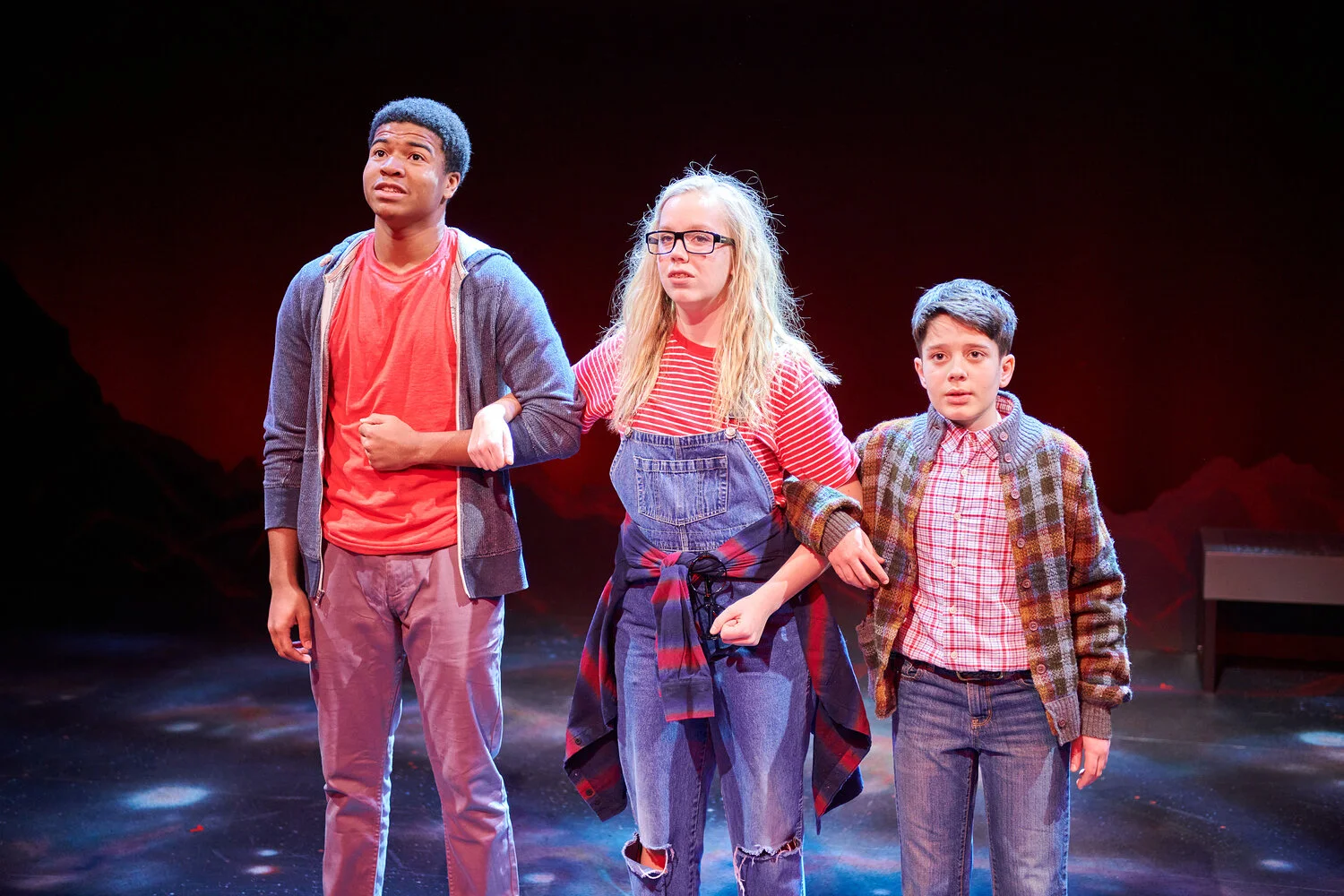Love Triumphs Over Hate in First Stage's "A Wrinkle in Time"
Photo by Mark Ruffolo.
Long before J.K. Rowling introduced the world to a trio of misfits — including the ridiculously smart Hermione Granger — who would sweep readers into a science fiction/fantasy adventure, where kids fight forces of evil with the guidance of a few eccentric adult teachers, there was Madeleine L’Engle’s “A Wrinkle in Time.” A female author entering into the world of outer space battles with a strong young woman protagonist was groundbreaking when the book was published, in 1962. For the first time large numbers of both boys and girls were engaged in interplanetary wars that pitted good against evil.
In the past, the Newbery Medal-winning “A Wrinkle in Time” has been called un-adaptable, and based on the reception of both a Disney TV movie and the 2018 feature film starring Reese Witherspoon and Oprah Winfrey, that label is not unfounded. (There have also been opera and graphic novel versions of the story.) Now First Stage brings “A Wrinkle in Time” to its children’s theater stage. Under the direction of Artistic Director Jeff Frank, it continues at the Marcus Center’s Todd Wehr Theater through February 23.
The plot follows young teen Meg (an impressively strong Lily Miller in the “space” cast) along with her oddly intuitive younger brother Charles Wallace (Abram Nelson) and their new friend Calvin (Nahjee Robinson) as they travel through time and space to rescue Meg’s dad. Missing for two years, the children’s father (Parker Gaspar Muñoz) is a scientist who got lost in his own top secret, government experiment.
Photo by Mark Ruffolo.
Along the way, the trio of young people are encouraged by a quirky band of intergalactic fairy godmothers: Mrs. Whatsit, who transforms from a patchwork cloaked witch to an enormous butterfly with rainbows for wings; Mrs. Which, who is only embodied as a glowing light; and Mrs. Who, an outlandish cross between an advanced physicist and a peculiar aunt, elaborately adorned in black and white. Along with setting the young people on their quest, the women warn of the extraordinary evil power of IT. A cross between a roving black hole and an enormous, writhing, nefarious brain, IT extinguishes good, both on earth and throughout the galaxy.
The most remarkable part of this production of “A Wrinkle in Time” is its stagecraft. Scenic design by Martin McClendon paints a starry universe with moons of many colors, both glowing on the theater’s back wall and its floor, enveloping the actors in the mysteries and vastness of outer space. Exceptional lighting design by Greg Hoffman creates the special effects of harrowing space travel and leads the young trio of explorers down mysterious hallways of the IT headquarters.
Frank uses two of his favorite stage effects to lift some of the magic of “Wrinkle in Time” off its pages; large scale puppetry and Japanese Bunraku (fully masked, black-clad figures who move other actors and set pieces around the stage as if they are flying). Both techniques give the piece superb theatricality while proving that the audience’s own imagination can do work more striking than the most high-tech CGI.
But as impressive as the production is technically, the story feels oddly bland. It touches on the theme of individuality versus conformity — all three of the kids are ridiculed for being strange, or at least different from their peers, and on their adventure they draw strength from their unusual gifts. Although Meg is told by one of her magical guides that her faults will save the day in the end, it is actually love that conquers hate in an exchange that is completely free from nuance.
Adult actors Elyse Edelman, Matt Daniels and Muñoz play multiple roles as the parents, whimsical guides, space monsters and evil forces. The most striking of the menagerie of characters is Daniels’s foray as the supervillain, clad completely in black with a fedora cocked on his head, his glowing red eyes hypnotize the kids as his prerecorded voice maniacally forecasts their doom. As the wacky Mrs. Who, Edelman turns in an entertaining performance using her voluminous black and white skirt to explain the process for making a literal wrinkle in time, the technique which allows the kids to travel to the edges of the galaxy in an instant. Narration, along with black cloaked Bunraku duties fall to the nine young performers in the ensemble who use their bodies impressively in both the foreground and background of the action.
More complicated than a fairy tale but less compelling than the average sci-fi movie, “A Wrinkle in Time” doesn’t fit easily fit into a genre, but it does give audiences some idea of what’s possible — both in the theater and when good people band together to fight darkness.

